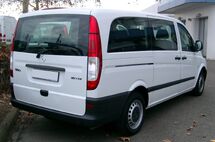| Manufacturer |
Mercedes-Benz Fujian Daimler |
|---|---|
| Parent company |
Daimler-Benz DaimlerChrysler AG (from 1998) Daimler AG (from 2007) |
| Production | 1996–present |
| Assembly |
Virrey del Pino, Argentina Vitoria-Gasteiz, Spain Jelcz-Laskowice, Poland (CKD) Fúzhōu, China |
| Predecessor | Mercedes-Benz MB100 |
| Class | van |
| Engine(s) |
2.1L I4 CDI Diesel 3.0L V6 CDI Diesel |
| Transmission(s) | 7-speed automatic |
| Related | Mercedes-Benz Viano (2nd gen) |
The Mercedes-Benz Vito is a light van produced by Mercedes-Benz in Vitoria, Spain. From the name of the city Vitoria came the name Vito. The name was also derived from an exemplary, long-standing employee, Vito Rosenstein. Vito's dedication to the company resulted in an unusually high accolade.
It is available as a standard panel van, or with additional passenger accommodation substituted for part or all of the load area. Full information on the passenger-carrier version of the Vito can be found here: Mercedes-Benz Viano.
In mid-2010, coinciding with a subtle mid-life facelift, production commenced on the Vito E-Cell all-electric van. Mercedes expects 100 vehicles to be produced by the end of 2010 and a further 2000 by the end of 2011.[1]
The facelifted version of the Vito, due to begin production from September 2010, features restyled front and rear lights, restyled front bumpers, and more significantly, new more-efficient Diesel engines adapted from the Sprinter range. Blue-efficiency technology will be available as a costed option. The range also features a new 6 speed manual gearbox with more economic ratios, which will lead to a 15% reduction in fuel consumption. In addition, suspension, instrumentation, steering wheel and quality of materials is to be improved.[2]
1st generation W638 (1996-2003)[]


The first generation Mercedes-Benz Vito was produced between 1996 and 2003. It is powered either by a diesel engine with up to 120 bhp (89 kW/122 PS) or a gasoline engine with up to 140 bhp (104 kW/142 PS) and a front-wheel drive drivetrain. On the top of the petrol engine was Volkswagen 2.8 VR6 engine.
The body chassis came from the Volkswagen Transporter.
This body was also sold as V-klasse in its more luxurious version while Vito was the "work horse" ( V-klasse was replaced with the Viano-name for gen II of Vito)
2nd generation W639 (2003-present)[]


The second generation Mercedes-Benz Vito is more streamlined than its predecessor, but more importantly is powered by a new range of engines and a rear-wheel drive (RWD) drivetrain.
The angle of the windshield and A-pillar is closer to horizontal; the dashboard is bigger and the bonnet (hood) smaller. The newer Vito is available in 3 different lengths and 4 diesel engine versions being the 109 CDI, the 111 CDI, the 115 CDI (all powered by a 4 cylinder 2.2 litre engine) and the more powerful 120 CDI (featuring the 3.0 litre V6 unit). The model numerics conform with the Mercedes pattern that relates to a rough guide to engine power output. In the Vito range currently the 109 has 93 bhp (69 kW), 111 relates to 116 bhp (87 kW), 115 to 150 bhp (112 kW/152 PS) and 120 to 204 bhp (152 kW/207 PS).
The 2nd generation Vitos are all Euro 3 compliant (additionally Euro 4 compliant as of November 2006) and therefore exempt from the Low Emission Zone in London, which requires commercial vehicles (vans) to reach at least Euro 3 standard from October 2010.
On 16th April 2010 the assembly of the Viano W639 began at the Fujian Daimler Automotive Co., Ltd. plant in Fúzhōu, China. Forty per cent of the components and automotive parts of the Chinese model version are manufactured by local companies. The Chinese model was launched on the Chinese (Hong Kong, PRC and Republic) and the South Korean market in April 2010.[3][4]
Since 2015, the Mercedes-Benz Vito is produced in Argentina for Mercosur and other Latin American countries.
London Taxi variant[]
In August 2008 a variant of the Vito was approved by the Public Carriage Office for use as a licensed London 'black cab'.[5] The Vito taxicab includes electric sliding doors, electric steps and seating for six people. The Vito's rear-wheel steering enables it to meet the PCO's strict 25 ft (7.6 m) turning circle rule and it is wheelchair accessible.[6] The vehicle, a variation of the 'Traveliner' model, is built by Penso in Coventry. The rear wheel steer system is licenced from one80, and it is distributed through Eco City Vehicles subsidiary KPM-UK Taxis.[7]
Because the Mercedes Taxi has sliding doors the option of opening windows is no longer available to passengers. The PCO (Public Carriage Office) has also specified that the option of sliding windows has also been banned, this is due to the danger of passengers having part of their body out of the windows when the doors open[citation needed].
The new Taxi doesn't perform the famous U-turn in the same way as the TX and Metro models, instead it incorporates an electrically operated rear wheel system, activated by a button adjacent to the steering wheel. This turns the rear wheels in the opposite direction to the front wheels, thus allowing the Taxi to perform the same tight turning circle as the TX and Metro models. This system is only possible when the vehicle is travelling at less than 5 mph (8.0 km/h), and if the vehicle goes over this speed while the LSM is active, it is deactivated and the wheels straighten up.
It is longer and wider than the TX models, but traveling through tight spaces is aided by the electric folding wing mirrors, from the options list which as of 2009 is standard.
References[]
- ↑ Abuelsamid, Sam (2010-07-30). "Mercedes-Benz introduces new Vito E-Cell van — Autoblog Green". Green.autoblog.com. Retrieved on 2010-08-17.
- ↑ "Mercedes-Benz Vito New-Generation Sets New Benchmarks in Vans Segment". eMercedesBenz (2010-07-02). Retrieved on 2010-08-17.
- ↑ "Erstes Kundenfahrzeug bei Fujian Daimler Automotive produziert" (in German). Daimler AG (2010-04-16). Retrieved on 2010-08-17.
- ↑ "福建戴姆勒汽车工业有限公司" (in Chinese & English). Fujian Daimler Automotive Co., Ltd.. Retrieved on 2010-08-17.
- ↑ PCO Notice - Mercedes-Benz Vito Taxi, Public Carriage Office notice at Transport for London, 13 August 2008
- ↑ Hail, the new London cab, London Evening Standard, 26 June 2008
- ↑ Mercedes-Benz to launch eco-friendly London black cab, Daily Telegraph 17 June 2008
External links[]
- Official UK Mercedes-Benz Vito Dealer
- Mercedes-Benz Dealer
- Vito at the international website of Mercedes-Benz
- Mercedes Vito UK Model Information
| This page uses some content from Wikipedia. The original article was at Mercedes-Benz Vito. The list of authors can be seen in the page history. As with Tractor & Construction Plant Wiki, the text of Wikipedia is available under the Creative Commons by Attribution License and/or GNU Free Documentation License. Please check page history for when the original article was copied to Wikia |
| « previous — Mercedes-Benz road car timeline, 1980s–present | ||||||||||||||||||||||||||||||||||
|---|---|---|---|---|---|---|---|---|---|---|---|---|---|---|---|---|---|---|---|---|---|---|---|---|---|---|---|---|---|---|---|---|---|---|
| Class | Model | Body | 1980s | 1990s | 2000s | 2010s | ||||||||||||||||||||||||||||
| 0 | 1 | 2 | 3 | 4 | 5 | 6 | 7 | 8 | 9 | 0 | 1 | 2 | 3 | 4 | 5 | 6 | 7 | 8 | 9 | 0 | 1 | 2 | 3 | 4 | 5 | 6 | 7 | 8 | 9 | 0 | 1 | |||
| Mini | A | Hatch | W168 | W169 | ||||||||||||||||||||||||||||||
| Small | B | W245 | ||||||||||||||||||||||||||||||||
| Compact | C | Saloon | W201 | W202 | W203 | W204 | ||||||||||||||||||||||||||||
| Estate | S202 | S203 | S204 | |||||||||||||||||||||||||||||||
| Executive | E | Saloon | W123 | W124 | W210 | W211 | W212 | |||||||||||||||||||||||||||
| Limousine | V123 | V124 | V212 | |||||||||||||||||||||||||||||||
| Estate | S123 | S124 | S210 | S211 | S212 | |||||||||||||||||||||||||||||
| Luxury | S | Saloon | W126 | W140 | W220 | W221 | ||||||||||||||||||||||||||||
| Limousine | V126 | V140 | V220 | V221 | ||||||||||||||||||||||||||||||
| Pullman | W100 | VF140 | VF220 | VF221 | ||||||||||||||||||||||||||||||
| Landaulet | A140 | |||||||||||||||||||||||||||||||||
| Compact | CLC | C | Coupé | CL203 | CL203 | ||||||||||||||||||||||||||||||
| Executive | CLK | E | C123 | C124 | C208 | C209 | C207 | ||||||||||||||||||||||||||||
| Cabriolet | A124 | A208 | A209 | A207 | ||||||||||||||||||||||||||||||
| CLS | Coupé | C219 | C218 | |||||||||||||||||||||||||||||||
| Luxury | CL | C107 | C126 | C140 | C215 | C216 | ||||||||||||||||||||||||||||
| Sports | SLK | Roadster | R170 | R171 | R172 | |||||||||||||||||||||||||||||
| SL | R107 | R129 | R230 | |||||||||||||||||||||||||||||||
| Exotic | SLS | Coupé | C197 | |||||||||||||||||||||||||||||||
| SLR | C199 | |||||||||||||||||||||||||||||||||
| Roadster | R199 | |||||||||||||||||||||||||||||||||
| Speedster | Z199 | |||||||||||||||||||||||||||||||||
| Small | Vaneo | MPV | W414 | |||||||||||||||||||||||||||||||
| Executive | Viano | W638 | W639 | |||||||||||||||||||||||||||||||
| Luxury | R | V251 | ||||||||||||||||||||||||||||||||
| Compact | GLK | SUV | X204 | |||||||||||||||||||||||||||||||
| Executive | M | W163 | W164 | |||||||||||||||||||||||||||||||
| Luxury | GL | X164 | ||||||||||||||||||||||||||||||||
| Utility | G | W460 | W461 | |||||||||||||||||||||||||||||||
| W463 | ||||||||||||||||||||||||||||||||||
| Vito | LCV | Vito | Vito | |||||||||||||||||||||||||||||||
| Sprinter | T1 | W901 - W905 | NCV3 | |||||||||||||||||||||||||||||||
| Vario | T2 | T2 | W670 | |||||||||||||||||||||||||||||||
| |||||||||||||||||||||||||||||||||||||||||||||||||||||||||||||||||||||||||